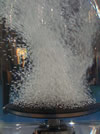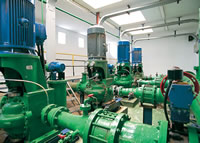
English
| 19/04/2024
|
| Home | Corporate Information | Business Lines | Ecological establishment seal | Present | Contact us | Legal info. |
Reduce your consumption up to 50%.
Adapt your consumption to your demand.
Less consumption. Less money.
More efficiency.
Reuse your water for
non-drinking purposes.
Quick information for
immediate decisions.
We assess your savings.
Prevention and control of Legionella.
BUSINESS LINES
WATER TREATMENT
|
Water treatment Methods | Water treatment process | Envioremental Impact
|
Water treatment process
 The treatment of waste water (residual, domestic or industrial water, etc.), it is a process of water treatment
that in turn incorporates physical, chemical and biological processes, which treat and remove physical, chemical
and biological pollutants of the effluent water. The aim of the treatment is to produce clean reusable water for
the environment.
The treatment of waste water (residual, domestic or industrial water, etc.), it is a process of water treatment
that in turn incorporates physical, chemical and biological processes, which treat and remove physical, chemical
and biological pollutants of the effluent water. The aim of the treatment is to produce clean reusable water for
the environment.
 The waste water is generated by residences, institutions, business and industrial premises. This can be treated
inside the site in which it is generated (for example: septic tanks or other means of purification). The efforts
to collect and to treat the domestic waste water are typically subject to regulations and based on local or state
standards. Industrial resources of waste water often need processes of specialized treatment.
The waste water is generated by residences, institutions, business and industrial premises. This can be treated
inside the site in which it is generated (for example: septic tanks or other means of purification). The efforts
to collect and to treat the domestic waste water are typically subject to regulations and based on local or state
standards. Industrial resources of waste water often need processes of specialized treatment.
Typically, the treatment of waste water is reached by the physical separation of solid domestic or industrial waters, followed by the progressive conversion of biological dissolved matter in a biological useful solid mass using suitable bacterias. As soon as the biological mass is separated or removed, the treated water can experience an additional disinfection by means of physical or chemical processes. The final effluent can be re-used for not drinkable uses.
These processes of treatment are typically recounted to one:
- Primary treatment (solid sedimentation)
- Secondary treatment (biological treatment of solid floating and settled)
- Tertiary treatment (additional steps like lagoons, micro filtration or disinfection).
The waste water are liquid residues from baths, wash basins, showers, etc; that are rejected to the sewers. The breakdown of the domestic water in grey waters and black waters is more common in the developed world. The black water is the one that comes from water closets and the grey water proceed from wash basins and tubs and can be used in irrigation of plants and recycled in the use of water closets.
|
Water treatment Methods | Water treatment process | Envioremental Impact
|
| Home | Corporate Information | Business Lines | Ecological establishment seal | Present | Contact us | Legal info. |








